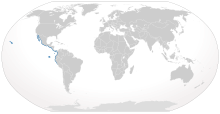| Diamond stingray | |
|---|---|

| |
| Scientific classification | |
| Domain: | Eukaryota |
| Kingdom: | Animalia |
| Phylum: | Chordata |
| Class: | Chondrichthyes |
| Subclass: | Elasmobranchii |
| Order: | Myliobatiformes |
| Family: | Dasyatidae |
| Subfamily: | Dasyatinae |
| Genus: | Hypanus |
| Species: | H. dipterurus
|
| Binomial name | |
| Hypanus dipterurus (D. S. Jordan & C. H. Gilbert, 1880)
| |

| |
| Range of the diamond stingray | |
| Synonyms | |
| |
The diamond stingray (Hypanus dipterurus) is a species of stingray in the family Dasyatidae. It is found in the coastal waters of the eastern Pacific Ocean from southern California to northern Chile, and around the Galápagos and Hawaiian Islands. This bottom-dweller generally inhabits sandy or muddy flats near rocky reefs and kelp forests, to a depth of 30 m (98 ft), though off Hawaii it may range considerably deeper. As its common name suggests, this species has an angular, diamond-shaped pectoral fin disc that is plain brown or gray above, with rows of tubercles along the midline and on the "shoulders". The long, whip-like tail has both dorsal and ventral fin folds, which distinguish this ray from the closely similar longtail stingray (H. longa). It typically grows to 1 m (3.3 ft) across.
When searching for food, diamond stingrays may form groups of up to hundreds of individuals. It is most active at night and preys mainly on burrowing invertebrates and small bony fishes, which are extracted from the bottom via suction or digging. This species is aplacental viviparous: once the embryos exhaust their yolk supply, they are nourished by histotroph ("uterine milk") produced by the mother. Females bear 1–4 pups every summer in estuaries; mating is followed by a ten-month period of either sperm storage or arrested embryonic development, after which the embryos rapidly mature over 2–3 months. The slowest-growing stingray known, this species is not resilient against fishing pressure. It is caught for food by artisanal fishers in Latin America, particularly in Mexico where it is one of the most economically important rays. This is assessed as Vulnerable by the International Union for Conservation of Nature (IUCN). Though innocuous towards humans, the diamond stingray's long, venomous tail spine is potentially dangerous.
